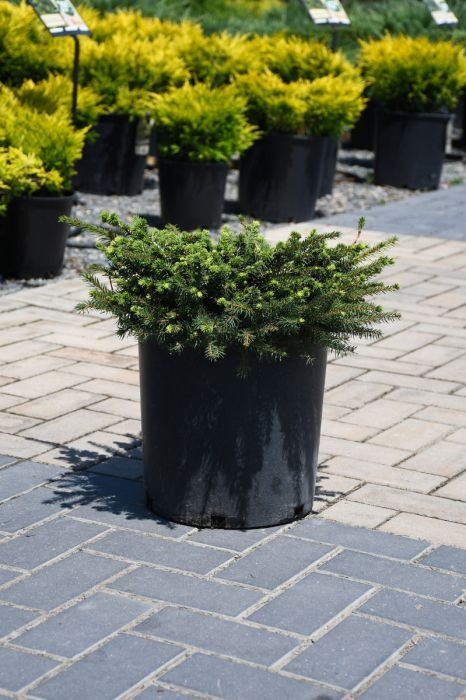Picea, Norway Spruce 'Bird's Nest'



- Sun Preference
- Full-Sun
Description
Broad, dense spruce that is compact growing. Light green foliage on slightly ascending, spreading branches.
Minnesota's Largest Selection of Shrubs
Elevate your landscaping with Gertens' unmatched variety of shrubs! Selecting the right shrubs for your backyard can enhance its beauty and functionality. Consider factors like sunlight, soil type, and mature size when choosing shrubs. For sunny areas, flowering shrubs like roses or hydrangeas can add color and charm. In shady spots, opt for shrubs like azaleas or hostas. Evergreen shrubs provide year-round interest and privacy, while deciduous shrubs offer seasonal color changes. At Gertens, we offer a wide selection of shrubs to suit every backyard need.
Details
Height: 3 feet
Spread: 4 feet
Sunlight: ![]()
![]()
Hardiness Zone: 3a
Other Names: Norwegian Spruce
Description:
Broad, dense spreading shrub which develops a characteristic depression in the center (hence the name), very unlike the species; forms a neat compact evergreen ball, adaptable and hardy; excellent choice for form and texture in the garden
Ornamental Features
Birds Nest Spruce has green foliage which emerges lime green in spring. The needles remain green throughout the winter. Neither the flowers nor the fruit are ornamentally significant.
Landscape Attributes
Birds Nest Spruce is a dense multi-stemmed evergreen shrub with a more or less rounded form. Its relatively fine texture sets it apart from other landscape plants with less refined foliage.
This is a high maintenance shrub that will require regular care and upkeep. When pruning is necessary, it is recommended to only trim back the new growth of the current season, other than to remove any dieback. Deer don't particularly care for this plant and will usually leave it alone in favor of tastier treats. It has no significant negative characteristics.
Birds Nest Spruce is recommended for the following landscape applications;
- Mass Planting
- General Garden Use
Planting & Growing
Birds Nest Spruce will grow to be about 3 feet tall at maturity, with a spread of 4 feet. It tends to fill out right to the ground and therefore doesn't necessarily require facer plants in front. It grows at a slow rate, and under ideal conditions can be expected to live for 50 years or more.
This shrub does best in full sun to partial shade. It does best in average to evenly moist conditions, but will not tolerate standing water. It is not particular as to soil type or pH, and is able to handle environmental salt. It is highly tolerant of urban pollution and will even thrive in inner city environments. This is a selected variety of a species not originally from North America.
| SKU | Container Size |
| E1230 | #2 Container (2 Gallon) |
| E1235 | #5 Container (5 Gallon) |
* Not all container sizes may be available at this time. See store for details on specific container size availability.
Bird's Nest Spruce | Picea abies 'Nidiformis'
Height: 3 feet
Spread: 4 feet
Sunlight: full sun to partial shade
Hardiness Zone: 3a
Other Names: Norwegian Spruce
Brand: Gertens
Description:
Broad, dense spreading shrub which develops a characteristic depression in the center (hence the name), very unlike the species; forms a neat compact evergreen ball, adaptable and hardy; excellent choice for form and texture in the garden
Ornamental Features
Bird's Nest Spruce is a dwarf conifer which is primarily valued in the garden for its ornamental globe-shaped form. It has rich green evergreen foliage which emerges lime green in spring. The needles remain green throughout the winter.
Landscape Attributes
Bird's Nest Spruce is a dense multi-stemmed evergreen shrub with a more or less rounded form. Its relatively fine texture sets it apart from other landscape plants with less refined foliage.
This is a high maintenance shrub that will require regular care and upkeep. When pruning is necessary, it is recommended to only trim back the new growth of the current season, other than to remove any dieback. Deer don't particularly care for this plant and will usually leave it alone in favor of tastier treats. It has no significant negative characteristics.
Bird's Nest Spruce is recommended for the following landscape applications;
- Mass Planting
- General Garden Use
- Planting & Growing
Bird's Nest Spruce will grow to be about 3 feet tall at maturity, with a spread of 4 feet. It tends to fill out right to the ground and therefore doesn't necessarily require facer plants in front. It grows at a slow rate, and under ideal conditions can be expected to live for 50 years or more.
This shrub does best in full sun to partial shade. It does best in average to evenly moist conditions, but will not tolerate standing water. It is not particular as to soil type or pH, and is able to handle environmental salt. It is highly tolerant of urban pollution and will even thrive in inner city environments. This is a selected variety of a species not originally from North America.
More Information
| Gerten Grown Plants | Gerten Grown Plants |
|---|---|
| Sun Preference | Full-Sun |
| Mature Height (Range) | 2 - 5 feet |
| USDA Hardiness Zone | 3, 4, 5, 6, 7, 8 |


